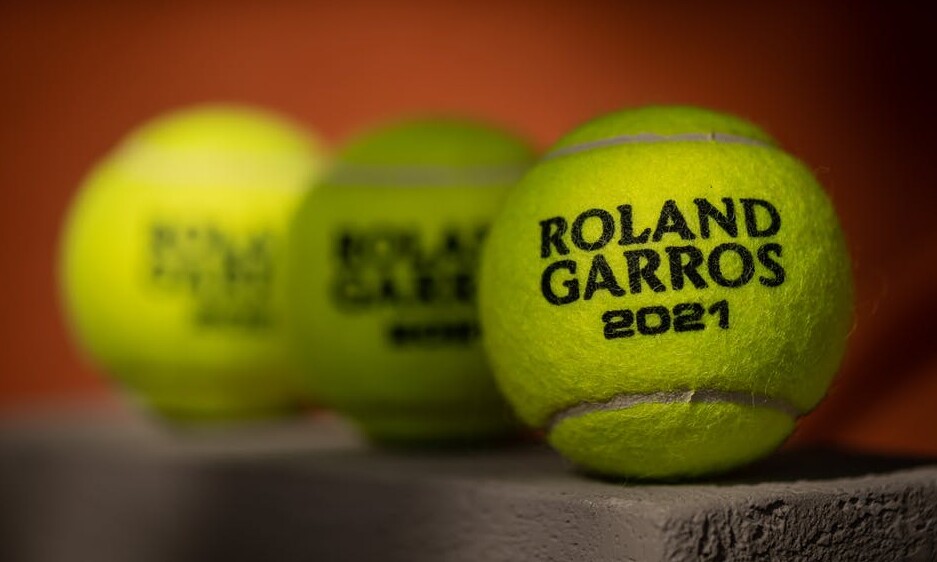In reality and previous years a Roland Garros postscript followed the tournament (see HL 116 “Roland Garros 2020, Plus Ca Change, Plus C’est La Meme Chose”). But this year a “pre” is in order, since as we begin to emerge from the pandemic the “Plus Ca Change” portion of the Parisian platitude for once has equal weight with the “Plus C’est La Meme Chose” part.

Djokovic, Nadal & Federer
First, we dispense with the sameness in the mens’ game. Rafael Nadal, Novak Djokovic and the brooding, though not corporeal omnipresence of Roger Federer still dominate. When Dominic Thiem defeated Alexander Zverev in a truly awful error and choke-filled U.S. Open final last September, it was the first Grand Slam championship for someone not of the Big Three since Stan Wawrinska’s defeat of Djokovic in the 2016 U.S. Open final. Unfortunately, (and unfairly as later explained) Thiem’s title will sport an asterisk “as big as the Ritz”[1] because neither Nadal (then entitled to be defending champ) nor Federer played and Djokovic exited in the fourth round, by nailing a lineswoman in the throat with an annoyed and errant ball slap. Order was soon restored when Nadal routed Djokovic (6-0, 6-2, 7-5) in the wrong season October 2020 Roland Garros final and Djokovic routed Danil Medvedev (7-5, 6-2, 6-2) in the Aussie Open final earlier this year.
Going into R.G. 2021, Nadal and Djokovic are in that order the prohibitive favorites to win the trophy won by Nadal or the other 14 of the last 16 years – with Federer and fellow Swiss Stan Wawrinka being the other two winners. Last Sunday’s Rome Masters final between Rafa and Nole (won 7-5, 1-6, 6-3 by Nadal) explains the bookies preconceptions (and ours) about what is most likely in Paris. The possible “Plus Ca Change” mens’ scenarios will be discussed after we discuss the womens’ game where ch-ch-ch-changes really are the story.[2]

Iga Swiatek
With the women it’s really the wild wild west. If last Sunday’s double bagel of former World 1 Karolina Pliskova by 19-year-old RG defender Iga Swiatek is indicative, she is likely to repeat. But we are not sure about that nor confident that after RG the Polish teenager’s established clay court wizardry will translate into top shelf performances in the grass and hard-court events that will dominate the rest of the 2021 calendar. Now we state our strong preference for both the womens’ and mens’ games to have a few truly consistently great and dominant players at the top.
A few decades back a Yankee broadcaster said to another, named Bill White, a former St. Louis Cardinals star, “Gee whiz Bill aren’t there a bunch of great teams this year” to which White responded “No there are not, just a few good teams – but none are great.”
That’s true of the highest ranked women today and the so-called “next gen” men such as Medvedev, Stefanos Tsitsipas, Zverev and their younger brethren, Jannik Sinner, Denis Shapovalov, Felix Auger-Aliassime, Sebastian Korda and possibly Reilly Opelka.

Serena Williams
But ladies first. The women who have attempted to succeed Serena and to a far lesser and more remote extent Venus and Maria Sharapova include Ash Barty, Naomi Osaka, Swiatek, Simona Halep, Sofia Kenin, Bianca Andreescu, Petra Kvitova, Garbine Muguruza and Victoria Azarenka – all who have won Grand Slam titles in recent years, and several two. They and the most prominent next gen first tier women include Aryna Sabalenka, Jennifer Brady, Coco Gauff and Amanda Anisimova. All of these women (like their male counterparts) have in discrete matches and tournaments played brilliantly, as good as it gets. With Halep’s 2019 6-2, 6-2 thrashing of Serena in the Wimbledon final, Kvitova’s nearly perfect 2014 Wimbledon finals defeat of Eugenie Bouchard (6-3, 6-0) and the 2018 and 2019 wins by Osaka and Andreescu over Serena coming to mind.
But none of the pretenders to Serena’s throne, with the exception of Osaka, has strung together even two great (forget winning) major tournaments. None, including Osaka have yet displayed the consistent excellence that Serena, Venus, Steffi Graf, Justine Henin, Monica Seles, Martina Navritilova, Christ Evert, Billie Jean King and Margaret Court did when they were atop the womens’ game. And with Osaka, the player touted elsewhere as most likely to ascend to that realm, there is an unanswered question of whether her brilliant hard-court game can be modified for real success on clay and grass courts – where her results to date have been mediocre. Unless and until she and/or one to three of the others demonstrate the consistent excellence of Serena and the Three Kings it will continue as it has for the last several years with a Kenin, Halep, Muguruza, Andreescu seeming to arrive but then quickly depart.

Navratilova, King & Evert
This lack of consistency is exemplified by the Sloane Stephens/Madison Keys U.S. Open final in 2017 followed by erratic results and their current rankings of 65 and 24, resulting in their unseeded meeting in the first instead of last round of the recent Rome tournament.
There also is a serious structural problem in the womens’ game, discussed ad nauseum since time immemorial, but never addressed. It is the best of three set format for the womens’ majors. Imagine a distinct possibility, that the 6-0, 6-0 46-minute Rome final on May 16, 2021 occurs again on June 12 at R.G. in Paris. We attended such a disaster last century at Forest Hills, when Maria Bueno breadsticked and bageled Carole Caldwell (6-1, 6-0) in the 1964 U.S. final, taking less than an hour. UN Secretary General U Thant presented the trophies and told Caldwell that “I’m sure with practice you’ll improve.” Even the worst mens’ Grand Slam routs (with Nadal/Djokovic R.G. 2020, Djokovic/Nadal Australia 2019 and Nadal/Federer R.G. 2008 coming to mind) do not bomb as miserably nor result in booing as last Sunday’s final did. And that is because of the best of five format. Our proposed solution is making womens’ Grand Slam finals (and possibly semis as well) best of five. Precedent from the mens’ game is the former five set finals of Masters 1000 events that proceeded in earlier rounds in a best of three format. In Rome they still talk about the five set classics between Nadal and Coria and Nadal and Federer in 2005 and 2006. The “Battle of the Sexes” between Billie Jean King and Bobby Riggs was best of five, though she needed just three to win. The notion that women cannot sustain excellence in a five-set format is an archaic, sexist and ridiculous anachronism.

Maria Bueno
Over to the other men, including recent next genners led by reigning U.S. Open champion Thiem. He also has contested three other Grand Slam finals, losing twice to Nadal and once to Djokovic, while defeating each on the way to losing to the other. Thiem has a 16-18 record with the Big Three, has defeated each on their favorite surface and is 5-2 with Federer. He is still most likely to succeed despite a walkabout after his victory at the 2020 U.S. Open. Succeed, not necessarily in the manner nor the degree that the Big Three have and Rod Laver and Pete Sampras did previously, but in the still glorious manner Andre Agassi, John McEnroe, Jimmy Connors and Jim Courier did (albeit in a 3-year sprint) and like Rosewall, Hoad, Gonzalez and other giants of earlier eras had.
And what of others beyond Thiem? Medvedev, current World 2 because of a pandemic ranking anomaly that may severely hurt this year’s Roland Garros,[3] well he is an abysmal 11-20 lifetime on clay and a good but not great 18-12 on grass. Contrast with the Big Three’s amazing records on their “worst” surfaces. Medvedev may as U Thant recommended “improve with practice” but his observations about clay that “this surface is awful” and “you like to be on dirt like a dog?” don’t auger well for him.

Reilly Opelka
Of the other current top 10 men, Tsitsipas is the leading candidate for what we defined as true greatness. He’s a five-tool ballplayer with an every surface game and more importantly not overawed by the Big Three, whom he regularly skewers on social media.
The seemingly (to some) equally talented Zverev is not like Tsitsipas, a Greek, but is possessed of a tragic flaw: his approach to and delivery of the second serve. Unless and until corrected, his game will be as the old saw says, “as good as his second serve” which will preclude consistent greatness. From that third younger group, those same three, i.e., Sinner, Korda and Opelka are our contenders. Sinner because he really appears to have the athletic ability, temperament and intelligence to succeed at the highest level. The first alone does not suffice. On the one hand think Nick Kyrgios and on the other watch Jon Wertheim’s 60 Minutes interview of Nadal last Sunday.
The two Americans are more aspirational on our part. We are patriotic about both and with Opelka it would be just so much fun to see Paul Bunyan win Wimbledon.
[1] F. Scott Fitzgerald’s words.
[2] We know you know its Bowie, but classic liberals are candy-asses when it comes to attributions.
[3] Nadal will be seeded 3, despite being defending champ, winner of 13 of the last 16 and despite being winner of 2 of the four big clay tournaments deemed “the road to Roland Garros this year. That may result in a Nadal/Djokovic semifinal, as occurred in 2013 when for other screwy reasons the King of Clay was seeded 5. Nadal’s five set victory over Djokovic in that semi is a classic but set up and anticlimactic final in which Nadal defeated David Ferrer.



0 Comments